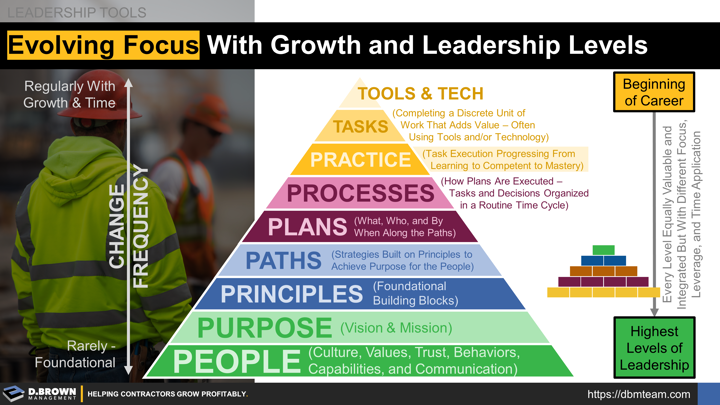Each stage of growth requires a different leadership focus. These seem similar but are as different as the states of matter moving from solid to liquid to gas.
Consider the progression for you and your team members through these stages as being like water at different temperatures. At 33 degrees, water is simply very cold, while at 211 degrees, it is very hot. This is analogous to moving through stages of growth and leadership. Just as water changes with temperature, individuals advance from beginners to experts in their roles.
Some job role changes happen with title changes. For example, promoting a Project Manager to Operations Manager.
Other job role changes happen with size and condition changes for the organization. For example, the job role of President in a Stage 3 contractor with 50 employees is dramatically different than the role of President in a Stage 5 contractor with 500 employees. Another example is that the role of President for two similar-sized contractors is very different based on whether the next 5-10 years is focused on refinement and growth within existing markets or whether they need to navigate the business into different markets to reignite growth and long-term sustainability. Different Stages of Growth, Challenges and People Required
In general, growth in job roles and contractor size follows a path from more of a focus on tools and technology to more of a people focus.
Interview & Evaluation Tip: Ask questions about specific experiences and see where someone's language is centered. Watch your own language. Look at your own time. Some people have a wide range and can easily navigate from concept to people through to tools and concrete action items then back as needed by the situation. This is extremely rare and not necessary for building a team.
In general, the larger the organization, the top leaders must have increasing levels of Relationships, Experience, Emotional Intelligence (EI), Situational Awareness, and longer convenient planning time horizons. Thinking progressively moves toward the more ambiguous and conceptual with robust layers of management ensuring appropriate details are added to turn the concepts into concrete actions on the front-line. In a few sentences, the leadership focus at each stage of growth is:
- Starting Up: Knowing what needs to be done, how to do it, and finding a customer to pay for it.
- Basic Foundation: Teaching and trusting others to know what needs to be done and how.
- Refinement: Managing others to produce consistent outcomes given the inconsistencies including customers, projects, suppliers, and people.
- Scalable Foundation: Aligning people, processes, tools, and technology across the whole company to improve outcomes, scalability, and resiliency.
- Ready to Scale: Aligning the team around common vision, values, and the long-term strategies required for sustainable growth including succession. Systematizing the talent pipeline for key functions.
- Sustainable Scaling and Succession (S3): Sustaining the business including governance, strategy, succession, and scalability for all economic conditions. Strategy, planning, risk, and succession at all levels are becoming more systematic rather than task-oriented.
Note that it is very common for a business to scale with the Owner/CEO/President filling in several of these leadership levels.
- If this is done short-term as part of developing the management team, or as an interim step due to someone leaving the management team, that is normal and healthy.
- If this is done because concentrating decision rights is most efficient, this will often produce great results but is opening up the equivalent of a potential sinkhole in the organization because the underlying road base and subgrade isn't strong enough.
Evaluating a Contractor's Leadership and Management Team
While there are a lot of nuances to how this is done and applied, below are the general steps we take when working with a contractor. The only focus of evaluation is to develop plans for improving the team and growing the business with the right balance of aggressiveness, financial conservativeness, and operational deliberateness.
- Comparative to Market: Unbiased but experienced third-party evaluation of the company and management team as compared to other contractors. Evaluated against stages of growth, leadership focus, strategies, development phase of the management team, and management systems.
- Self-Evaluation Accuracy: Evaluating the similarities and differences in how the management team self-evaluates between themselves and as compared to the evaluation against the market – #1 above.
- Vision (Strategic & Time Horizon): Evaluating how the management team envisions the future state of the market, business, and the management team including the ranges of time horizons each are envisioning.
- Business Modeling & Planning: Evaluating the clarity and quality of how the management team plans between current and future state at the people, strategy, structure, and systems levels.
- Execution: Evaluating how the management team executes those longer-term strategies and plans given the ambiguity of a changing environment over time and the need to balance with daily operations including continuous improvement.
While we do this in the course of working with contractors, the same basic steps can be used internally. We will share openly the various ways we do this and create constructive plans as an outcome. Please don't hesitate to contact us to confidentially discuss the nuances of your company and team.



